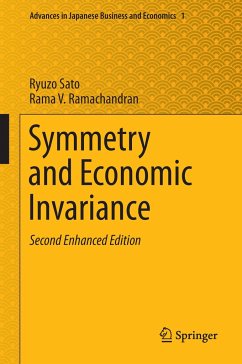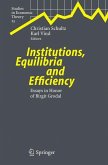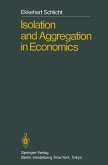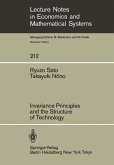- Gebundenes Buch
- Merkliste
- Auf die Merkliste
- Bewerten Bewerten
- Teilen
- Produkt teilen
- Produkterinnerung
- Produkterinnerung
Symmetry and Economic Invariance (second enhanced edition) explores how the symmetry and invariance of economic models can provide insights into their properties. Although the professional economist of today is adept at many of the mathematical techniques used in static and dynamic optimization models, group theory is still not among his or her repertoire of tools. The authors aim to show that group theoretic methods form a natural extension of the techniques commonly used in economics and that they can be easily mastered. Part I provides an introduction that minimizes prerequisites including…mehr
Andere Kunden interessierten sich auch für
![Information and Pricing in Road Transportation Information and Pricing in Road Transportation]() Richard H.M. EmmerinkInformation and Pricing in Road Transportation74,99 €
Richard H.M. EmmerinkInformation and Pricing in Road Transportation74,99 €![Institutions, Equilibria and Efficiency Institutions, Equilibria and Efficiency]() Institutions, Equilibria and Efficiency110,99 €
Institutions, Equilibria and Efficiency110,99 €![Isolation and Aggregation in Economics Isolation and Aggregation in Economics]() Ekkehart SchlichtIsolation and Aggregation in Economics42,99 €
Ekkehart SchlichtIsolation and Aggregation in Economics42,99 €![Rational Choice and Social Welfare Rational Choice and Social Welfare]() Rational Choice and Social Welfare74,99 €
Rational Choice and Social Welfare74,99 €![Invariance Principles and the Structure of Technology Invariance Principles and the Structure of Technology]() R. SatoInvariance Principles and the Structure of Technology42,99 €
R. SatoInvariance Principles and the Structure of Technology42,99 €![Handbook of Utility Theory Handbook of Utility Theory]() Handbook of Utility Theory256,99 €
Handbook of Utility Theory256,99 €![Democratic Governance and Economic Performance Democratic Governance and Economic Performance]() Dino FalaschettiDemocratic Governance and Economic Performance125,99 €
Dino FalaschettiDemocratic Governance and Economic Performance125,99 €-
-
-
Symmetry and Economic Invariance (second enhanced edition) explores how the symmetry and invariance of economic models can provide insights into their properties. Although the professional economist of today is adept at many of the mathematical techniques used in static and dynamic optimization models, group theory is still not among his or her repertoire of tools. The authors aim to show that group theoretic methods form a natural extension of the techniques commonly used in economics and that they can be easily mastered. Part I provides an introduction that minimizes prerequisites including prior knowledge of group theory. Part II discusses recent developments in the field.
Hinweis: Dieser Artikel kann nur an eine deutsche Lieferadresse ausgeliefert werden.
Hinweis: Dieser Artikel kann nur an eine deutsche Lieferadresse ausgeliefert werden.
Produktdetails
- Produktdetails
- Advances in Japanese Business and Economics 1
- Verlag: Springer / Springer Japan / Springer, Berlin
- Artikelnr. des Verlages: 978-4-431-54429-6
- 2nd ed.
- Seitenzahl: 288
- Erscheinungstermin: 19. Dezember 2013
- Englisch
- Abmessung: 241mm x 160mm x 22mm
- Gewicht: 574g
- ISBN-13: 9784431544296
- ISBN-10: 4431544291
- Artikelnr.: 37537483
- Herstellerkennzeichnung Die Herstellerinformationen sind derzeit nicht verfügbar.
- Advances in Japanese Business and Economics 1
- Verlag: Springer / Springer Japan / Springer, Berlin
- Artikelnr. des Verlages: 978-4-431-54429-6
- 2nd ed.
- Seitenzahl: 288
- Erscheinungstermin: 19. Dezember 2013
- Englisch
- Abmessung: 241mm x 160mm x 22mm
- Gewicht: 574g
- ISBN-13: 9784431544296
- ISBN-10: 4431544291
- Artikelnr.: 37537483
- Herstellerkennzeichnung Die Herstellerinformationen sind derzeit nicht verfügbar.
Ryuzo Sato Ryuzo Sato is C.V. Starr Professor Emeritus of Economics at the Stern School of Business, New York University. He was director of the Center for Japan-U.S. Business and Economic Studies at the Stern School. Prior to becoming a Stern faculty member, he was a professor of economics at Brown University. Professor Sato also taught at Harvard University, The University of Tokyo, Kyoto University, and Bonn University. He was the founding chief editor of Japan and the World Economy, an international theory and policy journal. For more than 40 years, Professor Sato has divided his time between Japan and the USA, and he conducts research, gives lectures, and writes on the subject of Japan-US relations. Recent work includes Biased Technical Change and Economic Conservation Laws (Springer, 2006), Growth Theory and Technical Change: The Selected Essays of Ryuzo Sato, vol. 1 (Edward Elgar, 1996), Production, Stability and DynamicSymmetry: The Selected Essays of Ryuzo Sato, vol. 2 (Edward Elgar, 1999), and Theory of Technical Change and Economic Invariance: Application of Lie Groups (Academic Press, 1981; reprint, new version, Edward Elgar, 1999). Professor Sato also writes columns regularly for several Japanese newspapers. Professor Sato, who was a Fulbright Scholar, received his B.A. in economics and his Dr. Economics from Hitotsubashi University in Tokyo, and his Ph.D. in economics from Johns Hopkins University. His principal areas of research interest are mathematical economics and economic growth. Rama V.Ramachandran Rama V.Ramachandran received his master's degree from Madras University, India, and his Ph.D. from Brown University in the U.S.A. He was a faculty member of the Department of Economics of Southern Methodist University and the Department of Economics of the Stern School of Business, New York University. He was associate director of the Center for Japan-U.S. Business and Economics at the Stern School. His research interests were in microeconomics and growth theory. After retirement, he has focused on economic pedagogy and authored an innovative introduction to microeconomics, Opportunities and Choices: Understanding Our Economic Decisions. (http://www.visualeconomicanalysis.info/index.html)
Part I Introduction
1 Introduction
1.1 GROUP THEORY AND CLASSIFICATION OF MATHEMATICAL STRUCTURE
1.2 LIE GROUPS AND INVARIANCE
1.3 ECONOMIC APPLICATIONS OF LIE GROUPS
2 Technical Progress and Economies of Scale: Concept of Holotheticity
2.1 A REFORMULATION OF THE PROBLEM
2.2 LIE GROUPS
2.3 HOLOTHETICITY
2.4 CONCLUSION
3 Holothetic Production Functions and Marginal Rate of Technical Substitution
3.1 TYPES OF TECHNICAL PROGRESS FUNCTIONS AND HOLOTHETICITY
3.2 MARGINAL RATE OF TRANSFORMATION AND EXTENDED TRANSFORMATION
3.3 HOLOTHETICITY AND LIE BRACKET
3.4 CONCLUSION
4 Utility and Demand
4.1 INTEGRABILITY CONDITIONS
4.2 CONCLUSION
5 Duality and Self Duality
5.1 DUALITY IN CONSUMER THEORY
5.2 SEPARABILITY AND ADDITIVITY
5.3 SELF-DUALITY IN DEMAND THEORY
5.4 A METHOD OF DERIVING SELF-DUAL DEMAND FUNCTIONS
5.5EMPIRICAL ESTIMATION OF SELF-DUAL DEMAND FUNCTIONS
5.6 IMPLICIT SELF-DUALITY OF PRODUCTION AND COST FUNCTIONS
5.7 CONCLUSION
6 The Theory of Index Numbers
6.1 STATISTICAL APPROACH
6.2 TEST APPROACH
6.3 ECONOMIC INDEX NUMBERS
6.4 DIVISIA INDEX
7 Dynamics and Conservation Laws
7.1 THE VARIATIONAL PROBLEM AND THE RAMSEY RULE
7.2 STEADY STATE AND THE GOLDEN RULES
7.3 THE HAMILTONIAN FORMULATION AND CONTROL THEORY
7.4 NOETHER THEOREM AND ITS IMPLICATIONS
7.5 CONSERVATION LAWS IN VON NEUMANN MODEL
7.6 MEASUREMENT OF NATIONAL INCOME AND INCOME-WEALTH RATIOS
7.7 CONCLUSION
Part II Recent Developments
8 The Invariance Principle and Income-Wealth Conservation Laws
8.1 INTRODUCTION
8.2 BRIEF SUMMARY OF THE LITERATURE
8.3 A MODEL WITH HETEROGENEOUS CAPITAL GOODS
8.4 NOETHER'S THEOREM (INVARIANCE PRINCIPLE
8.5 INCOME-WEALTH CONSERVATION LAWS
8.6 SPECIAL CASES
8.7 GENERALIZED INCOME/ WEALTH CONSERVATION LAWS
8.8 INCOME-CAPITAL (WEALTH) CONSERVATION LAW
IN THE VON NEUMANN MODEL
8.9 THE TOTAL VALUE CONSERVATION LAWOF THE FIRM
8.10 EMPIRICAL APPLICATIONS
8.11 SUMMARY
9 Conservation Laws in Continuous and Discrete Models---In memory of Professor Mineo Ikeda
9.1 INTRODUCTION
9.2 CONTINUOUS MODELS
9.3 DISCRETE MODELS (2012 VERSION) BY SHIGERU MAEDA
9.4 SUMMARY
10 Quantity or Quality: The Impact of Labour Saving Innovation on US and Japanese Growth Rates, 1960-2004
10.1 INTRODUCTION
10.2 A MODEL OF BIASED (LABOUR SAVING) TECHNICAL CHANGE
10.3 APPLICATIONS TO THE US AND JAPANESE DATA
10.4 CONCLUSION
11 A Survey on Recent Developments
11.1 Introduction
11.2 Extensions of the Income-Wealth Conservation Law
11.3 Externalities and Policy Interventions
11.4 Stochastic Income and Wealth Conservation Law
11.5 Warning
11.6 Conservation Laws and Helmholtz Conditions
11.7 Comparisons: Three Approaches
11.8 Hartwick Rule and Conservation Laws
11.9 More Abstract Applications of Group Theory to Economics and Finance
12 Appendix to Part II---Symmetry: An Overview of Geometric Methods in Economics
12.1 INTRODUCTION
12.2 TOOLBOX
12.3 HOLOTHETICITY: SYMMETRY OF THE ISOQUANT MAP
12.4 EXAMPLES OF CONSERVATION LAWS IN ECONOMICS
12.5 CONCLUSION
1 Introduction
1.1 GROUP THEORY AND CLASSIFICATION OF MATHEMATICAL STRUCTURE
1.2 LIE GROUPS AND INVARIANCE
1.3 ECONOMIC APPLICATIONS OF LIE GROUPS
2 Technical Progress and Economies of Scale: Concept of Holotheticity
2.1 A REFORMULATION OF THE PROBLEM
2.2 LIE GROUPS
2.3 HOLOTHETICITY
2.4 CONCLUSION
3 Holothetic Production Functions and Marginal Rate of Technical Substitution
3.1 TYPES OF TECHNICAL PROGRESS FUNCTIONS AND HOLOTHETICITY
3.2 MARGINAL RATE OF TRANSFORMATION AND EXTENDED TRANSFORMATION
3.3 HOLOTHETICITY AND LIE BRACKET
3.4 CONCLUSION
4 Utility and Demand
4.1 INTEGRABILITY CONDITIONS
4.2 CONCLUSION
5 Duality and Self Duality
5.1 DUALITY IN CONSUMER THEORY
5.2 SEPARABILITY AND ADDITIVITY
5.3 SELF-DUALITY IN DEMAND THEORY
5.4 A METHOD OF DERIVING SELF-DUAL DEMAND FUNCTIONS
5.5EMPIRICAL ESTIMATION OF SELF-DUAL DEMAND FUNCTIONS
5.6 IMPLICIT SELF-DUALITY OF PRODUCTION AND COST FUNCTIONS
5.7 CONCLUSION
6 The Theory of Index Numbers
6.1 STATISTICAL APPROACH
6.2 TEST APPROACH
6.3 ECONOMIC INDEX NUMBERS
6.4 DIVISIA INDEX
7 Dynamics and Conservation Laws
7.1 THE VARIATIONAL PROBLEM AND THE RAMSEY RULE
7.2 STEADY STATE AND THE GOLDEN RULES
7.3 THE HAMILTONIAN FORMULATION AND CONTROL THEORY
7.4 NOETHER THEOREM AND ITS IMPLICATIONS
7.5 CONSERVATION LAWS IN VON NEUMANN MODEL
7.6 MEASUREMENT OF NATIONAL INCOME AND INCOME-WEALTH RATIOS
7.7 CONCLUSION
Part II Recent Developments
8 The Invariance Principle and Income-Wealth Conservation Laws
8.1 INTRODUCTION
8.2 BRIEF SUMMARY OF THE LITERATURE
8.3 A MODEL WITH HETEROGENEOUS CAPITAL GOODS
8.4 NOETHER'S THEOREM (INVARIANCE PRINCIPLE
8.5 INCOME-WEALTH CONSERVATION LAWS
8.6 SPECIAL CASES
8.7 GENERALIZED INCOME/ WEALTH CONSERVATION LAWS
8.8 INCOME-CAPITAL (WEALTH) CONSERVATION LAW
IN THE VON NEUMANN MODEL
8.9 THE TOTAL VALUE CONSERVATION LAWOF THE FIRM
8.10 EMPIRICAL APPLICATIONS
8.11 SUMMARY
9 Conservation Laws in Continuous and Discrete Models---In memory of Professor Mineo Ikeda
9.1 INTRODUCTION
9.2 CONTINUOUS MODELS
9.3 DISCRETE MODELS (2012 VERSION) BY SHIGERU MAEDA
9.4 SUMMARY
10 Quantity or Quality: The Impact of Labour Saving Innovation on US and Japanese Growth Rates, 1960-2004
10.1 INTRODUCTION
10.2 A MODEL OF BIASED (LABOUR SAVING) TECHNICAL CHANGE
10.3 APPLICATIONS TO THE US AND JAPANESE DATA
10.4 CONCLUSION
11 A Survey on Recent Developments
11.1 Introduction
11.2 Extensions of the Income-Wealth Conservation Law
11.3 Externalities and Policy Interventions
11.4 Stochastic Income and Wealth Conservation Law
11.5 Warning
11.6 Conservation Laws and Helmholtz Conditions
11.7 Comparisons: Three Approaches
11.8 Hartwick Rule and Conservation Laws
11.9 More Abstract Applications of Group Theory to Economics and Finance
12 Appendix to Part II---Symmetry: An Overview of Geometric Methods in Economics
12.1 INTRODUCTION
12.2 TOOLBOX
12.3 HOLOTHETICITY: SYMMETRY OF THE ISOQUANT MAP
12.4 EXAMPLES OF CONSERVATION LAWS IN ECONOMICS
12.5 CONCLUSION
Part I Introduction
1 Introduction
1.1 GROUP THEORY AND CLASSIFICATION OF MATHEMATICAL STRUCTURE
1.2 LIE GROUPS AND INVARIANCE
1.3 ECONOMIC APPLICATIONS OF LIE GROUPS
2 Technical Progress and Economies of Scale: Concept of Holotheticity
2.1 A REFORMULATION OF THE PROBLEM
2.2 LIE GROUPS
2.3 HOLOTHETICITY
2.4 CONCLUSION
3 Holothetic Production Functions and Marginal Rate of Technical Substitution
3.1 TYPES OF TECHNICAL PROGRESS FUNCTIONS AND HOLOTHETICITY
3.2 MARGINAL RATE OF TRANSFORMATION AND EXTENDED TRANSFORMATION
3.3 HOLOTHETICITY AND LIE BRACKET
3.4 CONCLUSION
4 Utility and Demand
4.1 INTEGRABILITY CONDITIONS
4.2 CONCLUSION
5 Duality and Self Duality
5.1 DUALITY IN CONSUMER THEORY
5.2 SEPARABILITY AND ADDITIVITY
5.3 SELF-DUALITY IN DEMAND THEORY
5.4 A METHOD OF DERIVING SELF-DUAL DEMAND FUNCTIONS
5.5EMPIRICAL ESTIMATION OF SELF-DUAL DEMAND FUNCTIONS
5.6 IMPLICIT SELF-DUALITY OF PRODUCTION AND COST FUNCTIONS
5.7 CONCLUSION
6 The Theory of Index Numbers
6.1 STATISTICAL APPROACH
6.2 TEST APPROACH
6.3 ECONOMIC INDEX NUMBERS
6.4 DIVISIA INDEX
7 Dynamics and Conservation Laws
7.1 THE VARIATIONAL PROBLEM AND THE RAMSEY RULE
7.2 STEADY STATE AND THE GOLDEN RULES
7.3 THE HAMILTONIAN FORMULATION AND CONTROL THEORY
7.4 NOETHER THEOREM AND ITS IMPLICATIONS
7.5 CONSERVATION LAWS IN VON NEUMANN MODEL
7.6 MEASUREMENT OF NATIONAL INCOME AND INCOME-WEALTH RATIOS
7.7 CONCLUSION
Part II Recent Developments
8 The Invariance Principle and Income-Wealth Conservation Laws
8.1 INTRODUCTION
8.2 BRIEF SUMMARY OF THE LITERATURE
8.3 A MODEL WITH HETEROGENEOUS CAPITAL GOODS
8.4 NOETHER'S THEOREM (INVARIANCE PRINCIPLE
8.5 INCOME-WEALTH CONSERVATION LAWS
8.6 SPECIAL CASES
8.7 GENERALIZED INCOME/ WEALTH CONSERVATION LAWS
8.8 INCOME-CAPITAL (WEALTH) CONSERVATION LAW
IN THE VON NEUMANN MODEL
8.9 THE TOTAL VALUE CONSERVATION LAWOF THE FIRM
8.10 EMPIRICAL APPLICATIONS
8.11 SUMMARY
9 Conservation Laws in Continuous and Discrete Models---In memory of Professor Mineo Ikeda
9.1 INTRODUCTION
9.2 CONTINUOUS MODELS
9.3 DISCRETE MODELS (2012 VERSION) BY SHIGERU MAEDA
9.4 SUMMARY
10 Quantity or Quality: The Impact of Labour Saving Innovation on US and Japanese Growth Rates, 1960-2004
10.1 INTRODUCTION
10.2 A MODEL OF BIASED (LABOUR SAVING) TECHNICAL CHANGE
10.3 APPLICATIONS TO THE US AND JAPANESE DATA
10.4 CONCLUSION
11 A Survey on Recent Developments
11.1 Introduction
11.2 Extensions of the Income-Wealth Conservation Law
11.3 Externalities and Policy Interventions
11.4 Stochastic Income and Wealth Conservation Law
11.5 Warning
11.6 Conservation Laws and Helmholtz Conditions
11.7 Comparisons: Three Approaches
11.8 Hartwick Rule and Conservation Laws
11.9 More Abstract Applications of Group Theory to Economics and Finance
12 Appendix to Part II---Symmetry: An Overview of Geometric Methods in Economics
12.1 INTRODUCTION
12.2 TOOLBOX
12.3 HOLOTHETICITY: SYMMETRY OF THE ISOQUANT MAP
12.4 EXAMPLES OF CONSERVATION LAWS IN ECONOMICS
12.5 CONCLUSION
1 Introduction
1.1 GROUP THEORY AND CLASSIFICATION OF MATHEMATICAL STRUCTURE
1.2 LIE GROUPS AND INVARIANCE
1.3 ECONOMIC APPLICATIONS OF LIE GROUPS
2 Technical Progress and Economies of Scale: Concept of Holotheticity
2.1 A REFORMULATION OF THE PROBLEM
2.2 LIE GROUPS
2.3 HOLOTHETICITY
2.4 CONCLUSION
3 Holothetic Production Functions and Marginal Rate of Technical Substitution
3.1 TYPES OF TECHNICAL PROGRESS FUNCTIONS AND HOLOTHETICITY
3.2 MARGINAL RATE OF TRANSFORMATION AND EXTENDED TRANSFORMATION
3.3 HOLOTHETICITY AND LIE BRACKET
3.4 CONCLUSION
4 Utility and Demand
4.1 INTEGRABILITY CONDITIONS
4.2 CONCLUSION
5 Duality and Self Duality
5.1 DUALITY IN CONSUMER THEORY
5.2 SEPARABILITY AND ADDITIVITY
5.3 SELF-DUALITY IN DEMAND THEORY
5.4 A METHOD OF DERIVING SELF-DUAL DEMAND FUNCTIONS
5.5EMPIRICAL ESTIMATION OF SELF-DUAL DEMAND FUNCTIONS
5.6 IMPLICIT SELF-DUALITY OF PRODUCTION AND COST FUNCTIONS
5.7 CONCLUSION
6 The Theory of Index Numbers
6.1 STATISTICAL APPROACH
6.2 TEST APPROACH
6.3 ECONOMIC INDEX NUMBERS
6.4 DIVISIA INDEX
7 Dynamics and Conservation Laws
7.1 THE VARIATIONAL PROBLEM AND THE RAMSEY RULE
7.2 STEADY STATE AND THE GOLDEN RULES
7.3 THE HAMILTONIAN FORMULATION AND CONTROL THEORY
7.4 NOETHER THEOREM AND ITS IMPLICATIONS
7.5 CONSERVATION LAWS IN VON NEUMANN MODEL
7.6 MEASUREMENT OF NATIONAL INCOME AND INCOME-WEALTH RATIOS
7.7 CONCLUSION
Part II Recent Developments
8 The Invariance Principle and Income-Wealth Conservation Laws
8.1 INTRODUCTION
8.2 BRIEF SUMMARY OF THE LITERATURE
8.3 A MODEL WITH HETEROGENEOUS CAPITAL GOODS
8.4 NOETHER'S THEOREM (INVARIANCE PRINCIPLE
8.5 INCOME-WEALTH CONSERVATION LAWS
8.6 SPECIAL CASES
8.7 GENERALIZED INCOME/ WEALTH CONSERVATION LAWS
8.8 INCOME-CAPITAL (WEALTH) CONSERVATION LAW
IN THE VON NEUMANN MODEL
8.9 THE TOTAL VALUE CONSERVATION LAWOF THE FIRM
8.10 EMPIRICAL APPLICATIONS
8.11 SUMMARY
9 Conservation Laws in Continuous and Discrete Models---In memory of Professor Mineo Ikeda
9.1 INTRODUCTION
9.2 CONTINUOUS MODELS
9.3 DISCRETE MODELS (2012 VERSION) BY SHIGERU MAEDA
9.4 SUMMARY
10 Quantity or Quality: The Impact of Labour Saving Innovation on US and Japanese Growth Rates, 1960-2004
10.1 INTRODUCTION
10.2 A MODEL OF BIASED (LABOUR SAVING) TECHNICAL CHANGE
10.3 APPLICATIONS TO THE US AND JAPANESE DATA
10.4 CONCLUSION
11 A Survey on Recent Developments
11.1 Introduction
11.2 Extensions of the Income-Wealth Conservation Law
11.3 Externalities and Policy Interventions
11.4 Stochastic Income and Wealth Conservation Law
11.5 Warning
11.6 Conservation Laws and Helmholtz Conditions
11.7 Comparisons: Three Approaches
11.8 Hartwick Rule and Conservation Laws
11.9 More Abstract Applications of Group Theory to Economics and Finance
12 Appendix to Part II---Symmetry: An Overview of Geometric Methods in Economics
12.1 INTRODUCTION
12.2 TOOLBOX
12.3 HOLOTHETICITY: SYMMETRY OF THE ISOQUANT MAP
12.4 EXAMPLES OF CONSERVATION LAWS IN ECONOMICS
12.5 CONCLUSION
From the book reviews:
"The monograph provides an introduction to the application of group theory, a mathematical tool, to examine the structure of economic models. ... It will be useful for postgraduate students and researches specializing in dynamical models of economics." (Sergei Georgievich Zhuravlev, zbMATH, Vol. 1291, 2014)
"The monograph provides an introduction to the application of group theory, a mathematical tool, to examine the structure of economic models. ... It will be useful for postgraduate students and researches specializing in dynamical models of economics." (Sergei Georgievich Zhuravlev, zbMATH, Vol. 1291, 2014)








